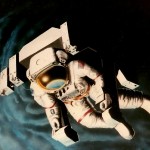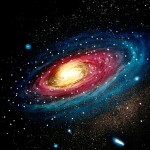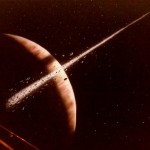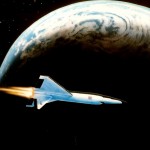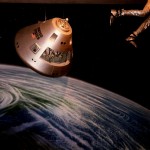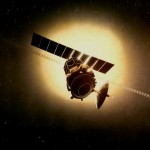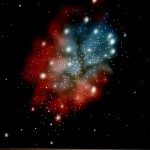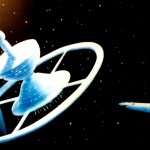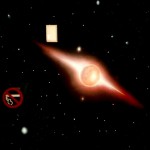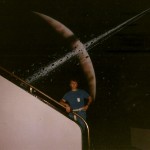In 1988, one of my first big museum clients, the Henry Crown Space Center at Chicago’s Museum of Science and Industry, asked me to do a grand, curving entrance mural calling for a satellite, a space-walking astronaut in an MMU, or Manned Maneuvering Unit (although the name tag on the suit is that of Anna Fisher, a woman astronaut), and the space shuttle against a 15-foot-wide slice of earth beyond.
They also asked for an upgrade to a lunar landscape scene which surrounds their LEM, or Lunar Excursion Module. This included placing six science experiment packages left on the lunar surface by the astronauts.
MSI supplied me with photos, dimensions and descriptions of the six items: the ALSEP Central Station, the Radio Isotope Thermo-electric Nuclear Generator, the Suprathermal Ion Detector Experiment, the Solar Wind Spectrometer, the Lunar Surface Magnetometer, and of course, the Passive Lunar Seismic Experiment. But no one could tell me where the units were placed in relation to the LEM.
Surely, NASA had planned the locations of these items with inconceivable precision, as they do everything else. And if some scientist came through the exhibit and found a misplaced ALSEP or Magnetometer, I’d certainly have to repaint something.
When I approached the Science Center director with my concern, he said, “I see, we’ve got a problem. Let me call Houston.” Does everybody with a problem call Houston?
A few hours later he interrupted my work and I followed him to an office phone. He said. “Here, this is Jack (or Gene, I don’t remember which it was). If he can’t tell you, no one can.”
I took the receiver and said, “Hi, this is Paul Barker.” The voice on the other end identified himself, and I immediately recognized the name as one of the moon walkers from a later Apollo landing. I was momentarily at a loss for words but eventually got my question out.
His response surprised me. “Hell, I don’t know, we just walked out a ways from the LEM and plopped ’em down wherever.”
“So I can put them anywhere? What if one of the Houston honchos comes through the exhibit?”
“Hey, if I couldn’t tell, who could, right? You gonna put our boot prints on the surface; that’s a big deal for us.”
“Sure.”
“Okay, just make sure mine are bigger than the other guy’s, and put more of them. I did more work. He just stood there, lookin’ at the earth.”
I went back to the exhibit and put the six units wherever whimsy demanded, knowing that future generations of visitors would never be aware of my wanton disregard for accuracy and that, in this age of immediate information at our fingertips, some mysteries can never be solved.
Here’s an antique video of the Space Center, which looks quite a bit different today.
